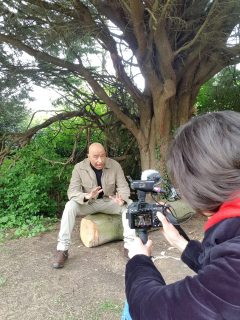
While world leaders negotiate agreements to mitigate the effects of climate change, local communities are already bearing the brunt of natural disasters spurred by the rapidly changing planet. In India’s Uttarakhand state, for example, a piece of a Himalayan glacier fell into a river in February 2021, triggering a massive flood that burst through a dam and a devastating landslide that left over 200 people dead or missing.
Capturing both the global and local scales of climate change in science stories is a challenge, especially for international reporters who serve audiences all over the world. Translation services can help them connect more directly with audiences in different regions. But it’s still up to the reporter to make their stories feel relevant and intelligible to a vast array of consumers.
London-based BBC global environment correspondent Navin Singh Khadka views these challenges as an opportunity to emphasize the stakes of global changes for individual communities. In covering the Uttarakhand flooding, for example, Khadka skillfully connects this local disaster to the broader dangers of unstable glaciers.
Khadka started his career covering human-interest stories for national media outlets in Nepal. But the 1992 United Nations Earth Summit in Rio de Janeiro, Brazil, which convened world leaders to discuss climate issues, sparked his interest in environmental journalism. Khadka joined the BBC as a general assignment reporter for its Nepali Service in Kathmandu and covered environmental issues on the side.
Now, he covers climate change and the environment for the BBC World Service in London, writing stories in English, Nepali, Hindi, and Urdu. Through BBC’s language services, his work is also translated into Spanish, Russian, Tamil, and more. Here, Khadka talks with journalist Abhaya Raj Joshi about how he finds compelling climate change stories from all over the world—sometimes without leaving his desk—and draws connections between global changes and local impacts. (This interview has been edited for length and clarity.)
How is reporting for an international media outlet different from working for national publications in Nepal?
When working in Nepal or any other country, you tend to focus on national issues that are related to your audiences of that country. [At the same time], you can’t escape the enormity of [climate change]. You cannot say, “I come from a small place and therefore I don’t need to understand all this bigger picture.”
That means understanding where the science stands today, what is the latest state of global action, what are the [climate] projections under different scenarios. You may not have to say all this to your readers, but you will need to understand it yourself first. And then you will need to ask what does all this mean to your region, your community, your audiences.
When working for international outlets, you have to think about stories in terms of how you could cater to those wider audiences. For example, the Uttarakhand disaster was definitely an Indian story, but there was a wider global interest in what happened. I found that glaciers around the world are becoming dangerous—they’re not just melting or shrinking or vanishing. The entire landscape is being destabilized [by climate change] and as a result you get all these cascading events. That is what we found in the Alps, the Andes, and the Himalayas.
How do you approach writing a story that will be translated into different languages?
I mostly write my copy in English, which is distributed centrally, and add relevant additional information for different languages. Usually language [services] translate my English piece, but for digital video and television outlets of languages that I speak (Hindi, Urdu, and Nepali, apart from English), I usually write the narration myself.
While trying to translate terminologies—like, for example, mitigation, adaptation—I prefer to explain them and not use straight word-to-word translations, as not all languages have ready-made translations for these terms.
It is important to help audiences understand why this story matters to them. That is where the local context comes in. For instance, when I did this forward-looking explainer, “COP27: Why Is Everyone Talking about Loss and Damage?,” I added a few paragraphs detailing what kind of losses and damages are being seen in [each] region. For instance, in the version for BBC Mundo I added some details of what is happening in Latin America. I did the same with African services [and] East and South Asian services.

How do you handle technical explanations in your stories, knowing that your readers might have varying levels of scientific literacy?
That is the real challenge. In many developing countries where many of our language services’ audiences are, the knowledge of topics like climate change, biodiversity, [and] energy might not be as high as in developed countries. So, the storytelling has to be simple and basic. The flip side is that it gives me a broad audience base: Millions of people are reading, or listening, or watching.
Another way of engaging with [diverse] audiences is offering them character-led stories, although the story may be issue-based or event-based. That helps present the story in a reader-friendly and interesting way. If you wrote [about] the issue with facts, figures, and quotes only, it might not work for those audiences. An example: a piece I did [for BBC Chinese] on how conservation of snow leopards has been possible because of youth conservationists in the range countries. This was used by several language services, and I had examples from Mongolia, Russia, and Nepal.
International reporting can involve a lot of traveling around the world—and a big carbon footprint. How do you decide whether a story can be reported from afar versus in-person?
It is very important to determine in the beginning what kind of story it is: Will text and pictures shared by local journalists’ work? Or will it need to be explained and shown from the ground? Definitely if you could do things remotely without traveling and without causing a carbon footprint, then it is nice.
Usually issue-based stories that may not be picture-[worthy] but are very important in terms of influencing positive policy-level changes can be done remotely—as long as we can get the voices of all sides involved and can understand what is going on even without being on the ground. Explainers, like “Five Ways Sequins Add to Plastic Pollution,” can be done from [my] desk.
But I would stress: It’s unfair to expect (particularly environmental) journalists not to travel. For example, when I did a story from Bosnia about the massive coal burning [industry] there, I could see [reporting] that story from here—I could just sit down and get some figures and facts. But being there and seeing for myself helps me give more details to my audience. I [could] say, “Oh my god, even at the airport, I’m smelling coal burning.”
When you aren’t traveling, how do you spot international story ideas from your desk in London?
Sometimes, major incidents happen and the majority of news media report [it], but there can be more to it than just straightforward pieces. For example, a massive oil spill in the East China Sea in 2018 was widely reported. But I found out that China had not banned fishing in those waters even two weeks after the incident.
Reading the full texts of reports and agreements is also important—you spot hidden stories. For example, when [President] Obama had a meeting with leaders during an India visit, everyone was talking about the broad deal between the two countries. But the agreement [also] said that American and Indian scientists were working on monitoring changes in the Bay of Bengal, [where a] massive volume of freshwater is coming into the ocean due to melting and retreating glaciers. The changing ratio of fresh water and salt water is influencing rainfall patterns.
Of all the climate change stories you’ve done, what is one that is close to your heart?
The story I did last winter, just before Christmas, about reindeer in Lapland—in northern Europe. The ground should have been covered with very soft snow so that those reindeer [could] dig and eat the lichen. But because of this change in temperature and rainfall, there was ice instead of snow. As a result, waves and waves of reindeer were running away from the area in search of food.
I was looking for a climate-related Christmas peg. It was fairly straightforward for some language services whose audiences are in places where celebrating Christmas is common. For others, I explained why it was not just about Christmas or reindeer but a very striking example of climate impacts and how animals are equally, if not more, impacted. The stories got massive hits on our website. Stories with startling images [like fleeing reindeer] or footage hammer in the message of climate change to the audience. It resonates with them and they remember it for a long time.

Abhaya Raj Joshi is a journalist based in Kathmandu, Nepal. He writes about the environment, wildlife, climate change, and technology. Follow him on Twitter @arj272.


